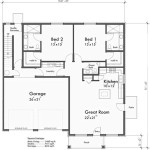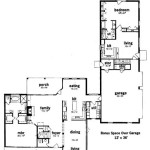A floor plan is a scaled drawing that shows the layout of a building’s floors. It can be used to determine the size and shape of each room, as well as the location of doors, windows, and other features. Floor plans are essential for planning renovations, additions, or new construction. They can also be helpful for visualizing the flow of traffic through a space and for making decisions about furniture placement.
There are several ways to find the floor plan of a house. One option is to ask the homeowner or builder for a copy. If the house is new, the floor plan may be included in the building permit. Another option is to hire a professional to draw up a floor plan. This is a good option if you need a detailed plan that is accurate to scale.
In the following sections, we will discuss the different ways to find the floor plan of a house. We will also provide tips for reading and understanding floor plans.
Here are 9 important points about how to find the floor plan of a house:
- Ask the homeowner or builder for a copy.
- Check the building permit.
- Hire a professional to draw up a floor plan.
- Use an online floor plan creator.
- Take measurements of the house yourself.
- Use a mobile app to create a floor plan.
- Look for floor plans in real estate listings.
- Contact the city or county planning department.
- Check with the homeowner’s association.
Once you have found a floor plan, be sure to review it carefully. Make sure that the plan is accurate and up-to-date. You may also want to make notes on the plan to help you visualize the space and plan your renovations or additions.
Ask the homeowner or builder for a copy.
If you are buying a house, the homeowner or builder should be able to provide you with a copy of the floor plan. This is especially true if the house is new or has been recently renovated. The floor plan may be included in the sales contract or it may be available on the builder’s website.
If you are not buying a house, you can still try to contact the homeowner or builder to ask for a copy of the floor plan. Be polite and explain why you need the plan. For example, you may be planning a renovation or addition, or you may be interested in buying the house in the future.
If the homeowner or builder is not able to provide you with a copy of the floor plan, you may be able to find one online. Many real estate websites allow you to search for homes by floor plan. You can also find floor plans on websites that specialize in home design and architecture.
Once you have found a floor plan, be sure to review it carefully. Make sure that the plan is accurate and up-to-date. You may also want to make notes on the plan to help you visualize the space and plan your renovations or additions.
Check the building permit.
If the house was built recently, the building permit may include a copy of the floor plan. To obtain a copy of the building permit, you can contact the city or county planning department. You will need to provide the address of the house and pay a small fee.
Once you have obtained a copy of the building permit, look for the section that contains the floor plan. The floor plan will typically be drawn to scale and will show the layout of the house, including the location of rooms, doors, and windows. You may also find other information on the building permit, such as the square footage of the house and the names of the contractors who worked on the project.
If you are unable to find a copy of the floor plan in the building permit, you can try contacting the homeowner or builder. They may have a copy of the floor plan on file.
Building permits are a valuable resource for finding floor plans. They are typically accurate and up-to-date, and they can be obtained for a relatively low cost.
Paragraph after details
Once you have found a floor plan, be sure to review it carefully. Make sure that the plan is accurate and up-to-date. You may also want to make notes on the plan to help you visualize the space and plan your renovations or additions.
Hire a professional to draw up a floor plan.
If you need a detailed and accurate floor plan, you may want to consider hiring a professional. A professional can create a floor plan that is to scale and that includes all of the details of your home, such as the location of walls, doors, windows, and fixtures. A professional floor plan can also include measurements and other information that can be helpful for planning renovations or additions.
There are many different types of professionals who can create floor plans. Architects, engineers, and draftsmen are all qualified to draw up floor plans. You can also find companies that specialize in creating floor plans for homeowners and businesses.
When hiring a professional to draw up a floor plan, be sure to ask about their experience and qualifications. You should also get a clear understanding of the cost of the project and the timeline for completion.
Once you have hired a professional, they will typically visit your home to take measurements and photos. They will then use this information to create a floor plan that meets your needs. Once the floor plan is complete, you will have a valuable resource that you can use to plan your renovations or additions.
Paragraph after details
Hiring a professional to draw up a floor plan is a good option if you need a detailed and accurate plan. A professional floor plan can be used to plan renovations, additions, or new construction. It can also be helpful for visualizing the flow of traffic through a space and for making decisions about furniture placement.
Use an online floor plan creator.
If you are comfortable using a computer, you can use an online floor plan creator to create a floor plan of your home. There are many different online floor plan creators available, both free and paid. Some popular options include Floorplanner, SmartDraw, and AutoCAD 360.
- Free and easy to use. Many online floor plan creators are free to use and do not require any special software or training. This makes them a good option for homeowners who need a simple floor plan for planning renovations or additions.
- Can be used to create detailed floor plans. Some online floor plan creators allow you to create detailed floor plans that include multiple levels, walls, doors, windows, and fixtures. These plans can be exported in a variety of formats, including PDF, JPG, and DWG.
- Can be used to collaborate with others. Some online floor plan creators allow you to share your plans with others. This can be helpful if you are working with a contractor or designer on a renovation or addition.
- May not be as accurate as professionally drawn floor plans. Online floor plan creators are not as accurate as professionally drawn floor plans. This is because they do not take into account factors such as the thickness of walls and the location of electrical outlets and plumbing fixtures.
If you need a detailed and accurate floor plan, it is best to hire a professional. However, if you need a simple floor plan for planning renovations or additions, an online floor plan creator can be a good option.
Take measurements of the house yourself.
If you are comfortable measuring and drawing, you can create a floor plan of your home yourself. To do this, you will need a tape measure, a pencil, and a piece of paper.
Start by measuring the perimeter of each room. Be sure to measure the length of each wall, as well as the width of each doorway and window. Once you have measured the perimeter of each room, you can start to draw the floor plan. Draw the walls to scale, and be sure to include the location of doors, windows, and other features.
Once you have drawn the floor plan, you can add details such as furniture, appliances, and fixtures. You can also use different colors and symbols to represent different types of rooms and features. For example, you could use blue to represent bedrooms, green to represent bathrooms, and red to represent kitchens.
Creating a floor plan of your home yourself can be a time-consuming process, but it can also be a rewarding one. A floor plan can be a valuable resource for planning renovations or additions, or for simply visualizing the flow of traffic through your home.
Here are some tips for taking measurements of your house yourself:
- Use a laser measuring device for accuracy. Laser measuring devices are relatively inexpensive and can be found at most hardware stores. They are much more accurate than traditional tape measures, and they can save you a lot of time.
- Measure the perimeter of each room first. This will give you a good starting point for drawing the floor plan. Be sure to measure the length of each wall, as well as the width of each doorway and window.
- Draw the walls to scale. This means that the length of each wall on the floor plan should be proportional to the actual length of the wall. You can use a ruler or a scale to help you draw the walls to scale.
- Add details such as furniture, appliances, and fixtures. This will help you to visualize the flow of traffic through your home and to plan renovations or additions.
Once you have created a floor plan of your home, you can use it to plan renovations or additions, or to simply visualize the flow of traffic through your home. A floor plan can be a valuable resource for homeowners, and it is a relatively easy project to complete yourself.
Use a mobile app to create a floor plan.
There are a number of mobile apps available that can help you to create a floor plan of your home. These apps are typically easy to use and can be a good option for homeowners who need a simple floor plan for planning renovations or additions.
To use a mobile app to create a floor plan, you will first need to download the app to your phone or tablet. Once the app is installed, you can open it and start creating your floor plan. Most apps will allow you to create a floor plan by drawing the walls of your home on the screen. You can also add doors, windows, and other features to your floor plan.
Once you have created a floor plan, you can save it to your phone or tablet. You can also share your floor plan with others via email or social media. Some apps also allow you to export your floor plan in a variety of formats, including PDF, JPG, and DWG.
Here are some of the benefits of using a mobile app to create a floor plan:
- Easy to use. Mobile apps are designed to be easy to use, even for people who have no experience with floor plan design.
- Affordable. Most mobile apps are free to download and use. Even the paid apps are relatively affordable.
- Convenient. You can use a mobile app to create a floor plan anywhere, anytime.
Here are some of the limitations of using a mobile app to create a floor plan:
- Not as detailed as professionally drawn floor plans. Mobile apps are not as powerful as professional floor plan design software. This means that they may not be able to create as detailed or accurate floor plans.
- May not be suitable for complex floor plans. Mobile apps may not be able to handle complex floor plans, such as those with multiple levels or irregular shapes.
Overall, mobile apps can be a good option for homeowners who need a simple floor plan for planning renovations or additions. However, if you need a detailed and accurate floor plan, it is best to hire a professional.
Here are some tips for using a mobile app to create a floor plan:
- Choose the right app. There are a number of different mobile apps available for creating floor plans. Do some research to find an app that is easy to use and meets your needs.
- Take accurate measurements. Before you start creating your floor plan, be sure to take accurate measurements of your home. This will help you to create a floor plan that is to scale.
- Draw the walls of your home first. This will give you a good starting point for creating your floor plan. Be sure to draw the walls to scale.
- Add doors, windows, and other features. Once you have drawn the walls of your home, you can start to add doors, windows, and other features. You can also use different colors and symbols to represent different types of rooms and features.
- Save your floor plan. Once you have created your floor plan, be sure to save it to your phone or tablet. You can also share your floor plan with others via email or social media.
Creating a floor plan of your home using a mobile app is a relatively easy and affordable project. By following these tips, you can create a floor plan that is accurate and useful for planning renovations or additions.
Look for floor plans in real estate listings.
If you are looking to buy a house, one of the best places to find a floor plan is in the real estate listing. Most real estate listings include a floor plan, either as a photo or as a downloadable PDF file. Floor plans in real estate listings are typically accurate and up-to-date, and they can be a valuable resource for buyers who are trying to visualize the layout of a home.
- Provides a clear understanding of the home’s layout. A floor plan shows the arrangement of rooms, hallways, and other spaces within a home. This can be helpful for buyers who want to get a sense of the home’s flow and functionality.
- Highlights the home’s key features. Floor plans often include details about the home’s key features, such as the number of bedrooms and bathrooms, the size of the rooms, and the location of special features like fireplaces and built-in storage.
- Can be used for comparison shopping. Floor plans can be used to compare the layouts of different homes. This can be helpful for buyers who are trying to find a home that meets their specific needs.
- Can be used for planning renovations or additions. If you are planning to renovate or add on to a home, a floor plan can be a valuable tool for planning your project.
If you are unable to find a floor plan in the real estate listing, you can try contacting the listing agent or the homeowner. They may be able to provide you with a copy of the floor plan.
Contact the city or county planning department.
The city or county planning department is another good source for floor plans. Many planning departments have a record of all building permits that have been issued in their jurisdiction. This includes permits for new construction, additions, and renovations. If you can find the building permit for your house, it may include a copy of the floor plan.
To obtain a copy of a building permit, you will need to contact the planning department for the city or county where your house is located. You will need to provide the address of the house and may be asked to pay a small fee.
Once you have obtained a copy of the building permit, look for the section that contains the floor plan. The floor plan will typically be drawn to scale and will show the layout of the house, including the location of rooms, doors, and windows. You may also find other information on the building permit, such as the square footage of the house and the names of the contractors who worked on the project.
If you are unable to find a copy of the floor plan in the building permit, you can try contacting the homeowner or builder. They may have a copy of the floor plan on file.
Building permits are a valuable resource for finding floor plans. They are typically accurate and up-to-date, and they can be obtained for a relatively low cost. However, it is important to note that not all building permits include a copy of the floor plan. If you are unable to find a floor plan in the building permit, you may need to try other methods, such as contacting the homeowner or builder.
Check with the homeowner’s association.
If your house is located in a homeowners association (HOA), the HOA may have a copy of the floor plan on file. HOAs are responsible for maintaining common areas and enforcing deed restrictions. They may also have a record of all building permits that have been issued for homes in the HOA. To obtain a copy of the floor plan from the HOA, you will need to contact the HOA management company.
The HOA management company may ask you to provide proof of ownership of your home. They may also charge a small fee for providing you with a copy of the floor plan. Once you have provided the necessary information and paid the fee, the HOA management company will send you a copy of the floor plan.
Floor plans from HOAs are typically accurate and up-to-date. However, it is important to note that not all HOAs have a copy of the floor plan for every home in the HOA. If the HOA does not have a copy of the floor plan for your home, you may need to try other methods, such as contacting the homeowner or builder.
Here are some tips for checking with the homeowner’s association for a floor plan:
- Contact the HOA management company. The HOA management company is responsible for maintaining the HOA’s records. They will be able to tell you if the HOA has a copy of the floor plan for your home.
- Provide proof of ownership. The HOA management company may ask you to provide proof of ownership of your home before they will release a copy of the floor plan.
- Pay the fee. The HOA management company may charge a small fee for providing you with a copy of the floor plan.
- Be patient. It may take some time for the HOA management company to locate the floor plan for your home. Be patient and follow up with them regularly.
Checking with the homeowner’s association is a good way to obtain a copy of the floor plan for your home. HOAs typically have accurate and up-to-date floor plans on file. However, it is important to note that not all HOAs have a copy of the floor plan for every home in the HOA. If the HOA does not have a copy of the floor plan for your home, you may need to try other methods, such as contacting the homeowner or builder.


:max_bytes(150000):strip_icc()/floorplan-138720186-crop2-58a876a55f9b58a3c99f3d35.jpg)







Related Posts








